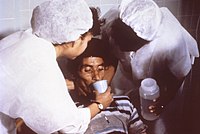
Photo from wikipedia
BackgroundSerum lactate and central venous oxygen saturation (ScvO2) are commonly used and commonly recommended as markers of tissue oxygenation in shock states. Medical literature has both explicitly stated and implied… Click to show full abstract
BackgroundSerum lactate and central venous oxygen saturation (ScvO2) are commonly used and commonly recommended as markers of tissue oxygenation in shock states. Medical literature has both explicitly stated and implied that the two biomarkers are interchangeable in the management of patients with shock. However, there have been relatively few direct comparisons of these tests in clinical circumstances, and the relationship between them is uncertain. The objective of our study was to evaluate whether simultaneous or near-simultaneous measurements of lactate and ScvO2 reveal a consistent relationship between these two biomarkers.MethodsA retrospective cohort study was conducted in an urban, academic US hospital. All adults in ICUs between March 2007 and March 2017 who had a lactate measurement and ScvO2 or mixed venous oxygen saturation (SvO2) measurement made +/− 1 h from the lactate were included. Linear and non-linear correlations of ScvO2 and lactate were assessed in a variety of shock states.ResultsTwo thousand sixty-two patients were included. Lactate and ScvO2 correlated poorly (r2 = 0.0041, p = 0.0019). This was true for patients with ScvO2 ≤ 65% (r2 = 0.0431, p < 0.001), patients with normal kidney and liver function (r2 = 0.0517, p < 0.001), and septic shock patients (r2 = 0.0037, p = 0.17). For patients with an O2 extraction ratio ≥ 50%, lactate and ScvO2 were strongly correlated (r2 = 0.93, p = 0.0019), but these patients represented only 2.8% of patients in whom the ratio could be calculated.ConclusionsLactate can predict ScvO2 when patients are at or below the critical oxygen delivery threshold, but relatively few shock patients meet this criterion. In the overall population of critically ill patients, serum lactate predicts ScvO2 poorly, even after controlling for factors that may affect lactate production. Lactate and ScvO2 should not be assumed to be interchangeable markers of tissue oxygenation/perfusion.
Journal Title: Journal of Intensive Care
Year Published: 2019
Link to full text (if available)
Share on Social Media: Sign Up to like & get
recommendations!